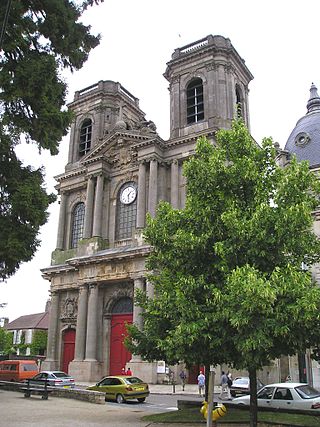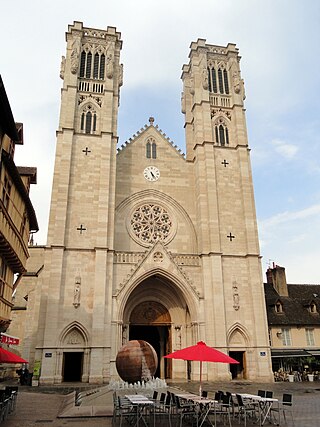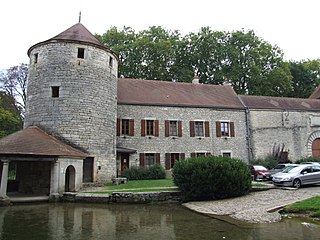
Robert II, called the Pious or the Wise, was King of the Franks from 996 to 1031, the second from the Capetian dynasty. Crowned Junior King in 987, he assisted his father on military matters. His solid education, provided by Gerbert of Aurillac in Reims, allowed him to deal with religious questions of which he quickly became the guarantor. Continuing the political work of his father, after becoming sole ruler in 996, he managed to maintain the alliance with the Duchy of Normandy and the County of Anjou and thus was able to contain the ambitions of Count Odo II of Blois.

Flavigny Abbey is a former Benedictine monastery, now occupied by the Dominicans, in Flavigny-sur-Ozerain, Côte-d'Or département, France. The monks at this abbey were the original makers of the well-known aniseed confectionery Anise de Flavigny.

The Diocese of Troyes is a Latin Church ecclesiastical territory or diocese of the Catholic Church in Troyes, France. The diocese now comprises the département of Aube. Erected in the 4th century, the diocese is currently a suffragan diocese in the ecclesiastical province of the metropolitan Archdiocese of Reims. It was re-established in 1802 as a suffragan of the Archbishopric of Paris, when it comprised the départements of Aube and Yonne and its bishop had the titles of Troyes, Auxerre, and Châlons-sur-Marne. In 1822, the See of Châlons was created and the Bishop of Troyes lost that title. When Sens was made an archdiocese, the episcopal title of Auxerre went to it and Troyes lost also the département of Yonne, which became the Archdiocese of Sens. The Diocese of Troyes covers, besides the ancient diocesan limits, 116 parishes of the ancient Diocese of Langres and 20 belonging to the ancient diocese of Sens. On 8 December 2002, the Diocese of Troyes was returned to its ancient metropolitan, the Archbishop of Reims. As of 2014, there was one priest for every 2,710 Catholics.

Saint Benignus of Dijon was a martyr honored as the patron saint and first herald of Christianity of Dijon, Burgundy. His feast falls, with All Saints, on November 1; his name stands under this date in the Martyrology of St. Jerome.

The Roman Catholic Diocese of Langres is a Roman Catholic diocese comprising the département of Haute-Marne in France.

The Roman Catholic Diocese of Autun (–Chalon-sur-Saône–Mâcon–Cluny), more simply known as the Diocese of Autun, is a diocese of the Latin Church of the Roman Catholic Church in France. The diocese comprises the entire Department of Saone et Loire, in the Region of Bourgogne.

Dijon Cathedral, or the Cathedral of Saint Benignus of Dijon, is a Roman Catholic church located in the town of Dijon, Burgundy, France, and dedicated to Saint Benignus of Dijon. The Gothic cathedral building, constructed between 1280 and 1325, and dedicated on 9 April 1393, is a listed national monument.

Symphorian, Timotheus (Timothy), and Hippolytus of Rome are three Christian martyrs who, though they were unrelated and were killed in different places and at different times, shared a common feast day in the General Roman Calendar from at least the 1568 Tridentine Calendar to the Mysterii Paschalis. While still a young man, Symphorian was either beheaded or beaten to death with clubs.
Manasses I, known as Manasses de Gournay, was the Archbishop of Reims, and thus primate of France, from c. 1069 to his deposition on 27 December 1080.

The Roman Catholic Archdiocese of Dijon is a diocese of the Latin Church of the Roman Catholic Church in France. The archepiscopal see is Dijon Cathedral, which is located in the city of Dijon. The diocese comprises the entire department of Côte-d'Or, in the Region of Bourgogne. Originally established as the Diocese of Dijon in 1731, and suffragan to the Archdiocese of Lyon, the diocese was elevated to the rank of archdiocese in 2002. The most significant jurisdiction change occurred after the Concordat of 1801, when the diocese annexed the department of Haute-Marne. In 1821, a papal bull re-established the Diocese of Langres. The current archbishop is Antoine Hérouard, appointed in 2022.
Sigo was a Burgundian abbot of the sixth century. He is a saint of the Roman Catholic Church, an Orthodox saint and the reputed founder of the Abbey of Saint-Seine and in the Orthodox Church.

The former French Catholic diocese of Chalon-sur-Saône existed until the French Revolution. After the Concordat of 1801, it was suppressed, and its territory went to the diocese of Autun. Its see was Chalon Cathedral.
Halinard was the Archbishop of Lyon between 1046 and 1052; he also served as abbot of the monastery of Saint-Bénigne in Dijon between 1031 and 1052. He was a counselor of both the Emperor Henry III and Pope Victor II.
Saint Cassian of Autun was a 4th-century bishop of Autun. He may have been an Egyptian by birth. He traveled to Autun and was a follower of Saint Reticius, bishop of Autun.
Venerable Lambert I was the count–bishop of Langres from 1016 until his death. He is sometimes called "Lambert of Vignory", but this is a result of confusion with bishop Lambert II. Nothing certain is known of his family, save that he had a married sister named Letgardis. Lambert was a cathedral provost under his predecessor, Bruno.
Argrim was one of the rival bishops of Langres following the disputed election of 888. He was the uncontested bishop after 899 until his retirement in 910. Before becoming bishop he was a monk of Saint-Bénigne de Dijon.

The Bèze Abbey, was a monastery founded in 629 AD in Burgundy, France. It was destroyed several times during the next three centuries by Frankish warlords, Saracens, Normans and Hungarians. At the end of the 10th century the abbey was re-founded and entered a golden age for the next two centuries. By the 13th century the spiritual life of the abbey had declined and the monks were mainly concerned with temporal matters. The abbey lost most of its monks during the Hundred Years' War and the Black Death of the 14th century. In 1429 it was fortified with stone walls, a moat and towers, two of which have survived. The abbey was again devastated by feuds in 1513, by the French Wars of Religion (1562–98) and by the Thirty Years' War (1618–48).
Prudent de Narbonne was a Christian deacon who was martyred in Narbonne in what is now France in the 3rd century. He is venerated by the Catholic Church as a saint. His relics are said to have effected various miracles. They were found in a church in Narbonne and taken to Bèze Abbey in 883. They were held for safe keeping during the Norman invasions in the cathedral of Saint-Étienne de Dijon, then returned to the abbey. Later they were restored to Narbonne, and are held in an elaborate reliquary in Narbonne Cathedral.

Gabriel Cortois de Quincey, clergyman, was Bishop of Belley from 1751 to 1791, the last of the Ancien Régime.
Saint John of Réôme was an early Christian abbot in what is now Moutiers-Saint-Jean in the Côte-d'Or department of France.










